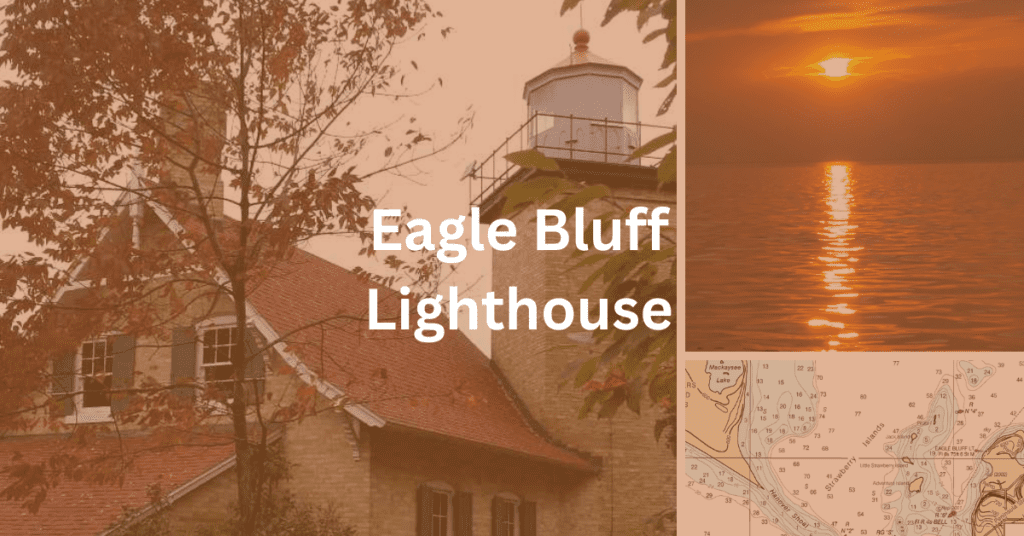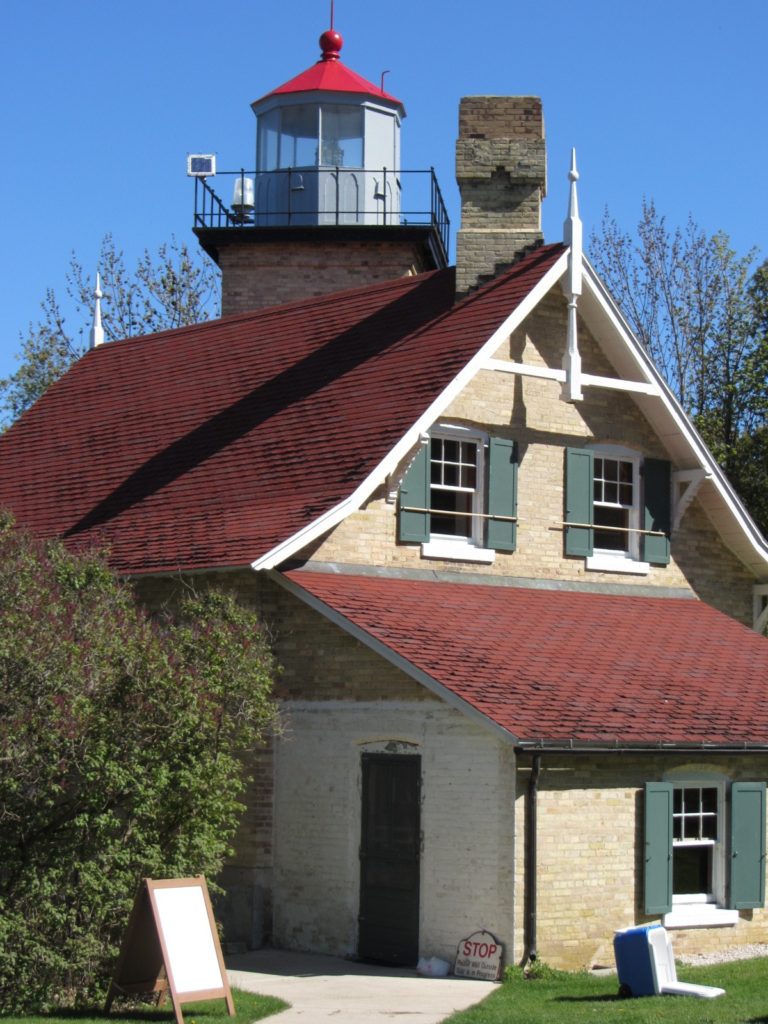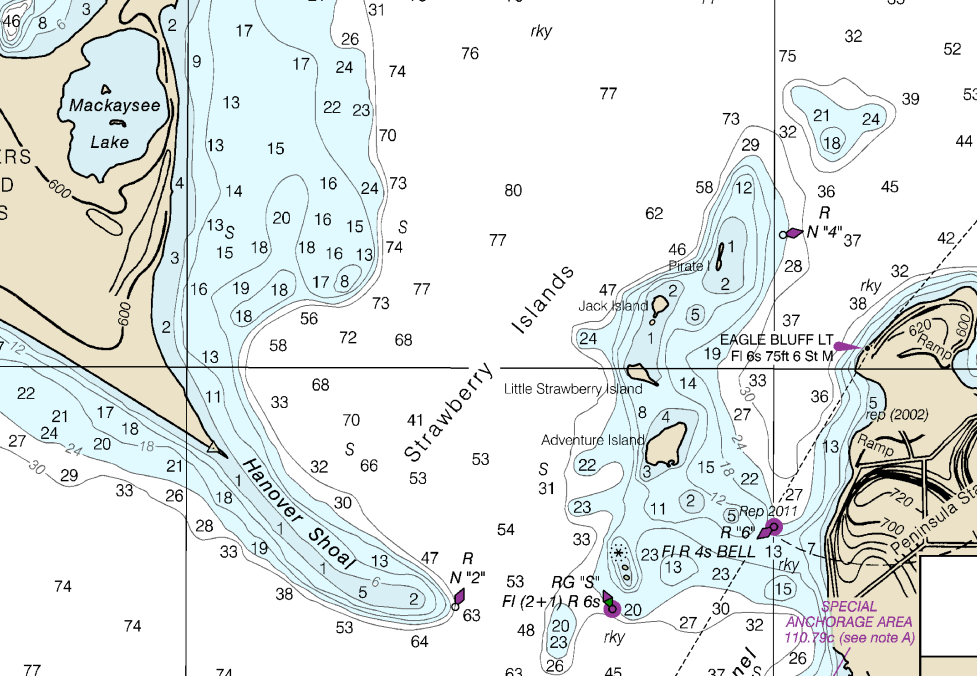The Eagle Bluff Lighthouse, located on the Door Peninsula, has played an important role in guiding ships safely through the Strawberry Channel for over 150 years. In this post, we will delve into the fascinating history of the Eagle Bluff Lighthouse, from its construction to its automation and preservation, and its current status as a beloved tourist destination. Join us as we explore the rich maritime heritage of Wisconsin and discover the story of the Eagle Bluff Lighthouse.
Here is what we will cover in this post:
- Quick Facts
- How to visit the Eagle Bluff Lighthouse
- History of the Eagle Bluff Lighthouse
- Frequently Asked Questions
- Summary
To learn more about all of Door County’s eleven lighthouses, check out our hub post on Door County lighthouses.

Eagle Bluff Lighthouse Quick Facts:
- Built in 1868
- Automated in 1926
- Inside Peninsula State Park
- Open for tours
Visiting the Eagle Bluff Lighthouse

This is the most accessible and easily visited lighthouse in Door County. Whereas accessing other lighthouses can require some unique transportation like ferries, one can drive right up to the Eagle Bluff Lighthouse.
The Eagle Bluff Lighthouse is located within Peninsula State Park. Therefore, an admission sticker is necessary in most cases, although there are a few ways to access Wisconsin state parks for free.
Visitors can access the grounds of the Eagle Bluff Lighthouse at any time. During the summer months, the Door County Historical Society gives tours of the lighthouse‘s interior for a small fee.
Map
History of the Eagle Bluff Lighthouse
The Eagle Bluff Lighthouse has a rich history that continues today.
The Need for a Lighthouse Identified
In the mid-1800s, the Great Lakes saw a surge in ship traffic due to increased trade and transportation, especially after the end of the Civil War. This increase in traffic also brought about an increased need for safe navigation. In 1865, the Lighthouse Board took notice of this and dispatched a committee to survey the western Great Lakes in order to identify the necessary infrastructure for navigation. After conducting their research, the committee identified the Strawberry Channel, a narrow and treacherous channel just off the Door Peninsula, as an area in dire need of a lighthouse. The location of the lighthouse was to be on the Eagle Bluff, which would provide clear visibility and guidance for ships navigating the Strawberry Channel. With the resources now available after the Civil War, the decision was made to construct the Eagle Bluff Lighthouse to ensure the safety of ships navigating through the Great Lakes.

Construction of the Lighthouse
In 1866, Congress designated $12,000 for the construction of the Eagle Bluff Lighthouse, and construction began in 1868. The lighthouse was built using cream city brick, a high-quality brick that was commonly used in the construction of buildings during that time. The dwelling itself was a one-and-a-half-story, end-gabled building with a shed-roofed addition for a kitchen. The tower had a footprint of 19 feet, four inches square, and was three stories high, with a spiral staircase leading to the top. The lantern room, located at the top of the tower, had ten sides and was fitted with a third-and-a-half-order Fresnel lens, which was state-of-the-art technology at the time. In later years, this was replaced by a fifth-order Fresnel lens.
After months of hard work, the construction of the Eagle Bluff Lighthouse was finally completed on October 13, 1868. The lighthouse stood tall and proud on top of the bluff, ready to guide ships safely through the treacherous Strawberry Channel. Its construction was a testament to the determination and ingenuity of the people who built it, and it remains a symbol of Wisconsin’s maritime heritage to this day.
Automation to the Present Day
In 1926, the Eagle Bluff Lighthouse was automated, relieving the need for a resident lighthouse keeper. Instead, maintenance of the light became the responsibility of the Cana Island Lighthouse keepers. The lighthouse continued to serve its purpose of guiding ships safely through the Strawberry Channel.
In the 1930s, the grounds around the lighthouse became a part of Peninsula State Park, and eventually, even the lighthouse structure became the property of the State of Wisconsin.
However, by the 1950s, neglect and vandalism had taken their toll on the Eagle Bluff Lighthouse. The once-beautiful structure had fallen into a state of disrepair and was in danger of being lost forever. Fortunately, in 1961, the Door County Historical Society recognized the lighthouse’s historical significance and began the process of renovating it.
After years of hard work and dedication, the Eagle Bluff Lighthouse was opened to public tours in 1963. Since then, it has become a popular attraction for tourists and history buffs alike. Today, visitors to the lighthouse can climb to the top of the tower and take in breathtaking views of the surrounding area, while also learning about the rich history of Wisconsin’s maritime heritage. The Eagle Bluff Lighthouse stands as a testament to the ingenuity, perseverance, and dedication of those who built it, and continues to be a source of inspiration for generations to come.
Frequently Asked Questions
Yes, visitors can climb the spiral staircase to the top of the tower, where they can enjoy stunning views of the surrounding area.
Yes, the lighthouse is open to the public for tours during the summer months. Visitors can learn about the history of the lighthouse and its role in Wisconsin’s maritime heritage.
The lighthouse was built using cream city brick and has a one-and-a-half-story dwelling with a shed-roofed addition for a kitchen. The tower is three stories high with a spiral staircase and a lantern room fitted with a third-and-a-half-order Fresnel lens. Construction was completed in 1868.
Summary
- The Eagle Bluff Lighthouse was constructed in 1868 with $12,000 designated by Congress.
- The lighthouse was built using cream city brick, has a one-and-a-half-story dwelling, and a 19 feet, four-inch square tower.
- It was automated in 1926, and its maintenance became the responsibility of the Cana Island Lighthouse keepers.
- The lighthouse is now a part of Peninsula State Park.
- In 1961, the Door County Historical Society began renovations due to neglect and vandalism.
- The lighthouse is open for public tours since 1963.
- The Eagle Bluff Lighthouse is located on the Door Peninsula, guiding ships safely through the Strawberry Channel.
